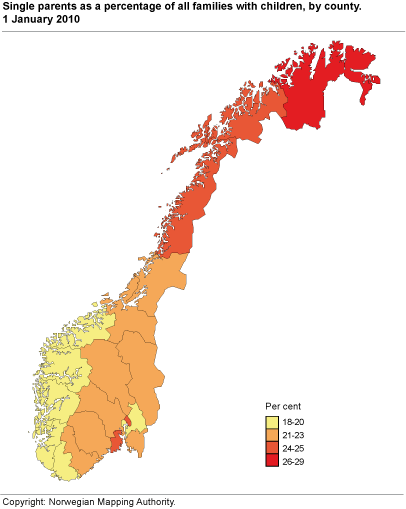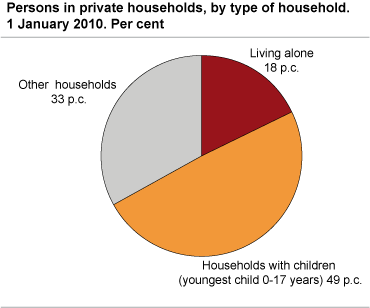Content
Published:
This is an archived release.
One in five alone
One in five Norwegians live alone, and about 60 per cent live as part of a couple. Three out of four couples are married. Oslo is the municipality with most persons living alone. Marriages are most common in the coastal counties from Østfold to Møre og Romsdal.
These are some of the main results from the register-based statistics on families and households.
Among the country's 3.7 million persons aged 18 and above, 59 per cent live as couples. Couples include in this context persons who are registered as living in the same dwelling and in addition are married, living as registered partners or as cohabitants. There are large regional differences. In Oslo, half of the population did not live as couples. In the neighbouring county of Akershus, the figure is 37 per cent, which is the lowest in Norway. A large portion of the couples in the Oslo/Akershus area seem to have chosen to settle in Akershus. In the Oslo/Akershus region, 56 per cent live as couples. This is close to the average for the whole country.
Seventy-seven per cent of the couples are married or registered partners, and 23 per cent are cohabiting couples. Living as cohabitants is a relatively new phenomenon. Furthermore, many couples are cohabitants for some time before getting married. Therefore, relatively many cohabiting couples are young people. Of all the couples aged between 18 and 29 years, approximately two thirds are cohabiting couples. For the age group 30-44 years, one third of the couples are married. Among persons 45-66 years old living as couples, only 14 per cent are cohabiting couples. Amongst the oldest; aged 67 years or more, only 4 per cent of those living as couples are cohabitants.
Most cohabiting couples in Oslo and in the northern counties
Oslo, Hedmark and Oppland, as well as the counties in Trøndelag and Northern Norway have the highest portion of cohabiting couples. Sør-Trøndelag was top in the rankings with 29 per cent. Vest-Agder was lowest with 13 per cent. Marriages are most common in the coastal counties from Østfold to Møre og Romsdal.
Families consisting of a single mother or father constitute 22 per cent of the total number of families with children less than 18 years old. One out of five are single fathers. We find the highest shares of families in this category in the northern part of Norway, with Finnmark on top with 29 per cent. The lowest shares of single parents are found in the counties of Rogaland and Sogn og Fjordane (18 per cent).
Same sex married couples
On 1 January 2009, the Marriage Act was changed in such a way that two persons of the same sex can be married, and new partnerships were abolished. Persons already in a partnership can change their partnership to a marriage, or continue their partnership. At the end of 2009, there were 900 families consisting of same sex married couples, 389 male couples and 511 female couples. Approximately 50 per cent of all same sex married couples lived in Oslo, 60 per cent of the male couples and 40 per cent of the female couples. Only 10 per cent of all married couples live in Oslo.
More people live alone
In Norway, 863 000 persons lived alone on 1 January 2010, almost one in five. Households consisting of one person made up 40 per cent of all households; an increase from 34 per cent in 1990 and 28 per cent in 1980. Persons living alone are mainly found in remote areas and in the large cities, especially in the central parts of the cities. In the municipalities surrounding the large cities, relatively few people are living alone.
Oslo is the municipality with most persons living alone. 29 per cent of the population live alone, and more than half of all the households in Oslo consist of one person. There were, however, large differences between parts of the city. In the inner city, approximately two thirds of the households consist of people living alone. On the opposite side we find the urban district Søndre Nordstrand with only every third household consisting of one person.
Also in central parts of the cities of Bergen, Stavanger and Trondheim we find regions with high levels of persons living alone.
Old people live alone
The proportion of persons living alone in private households is highest among the elderly. Almost 6 out of 10 persons aged 80 years or more live alone, and 1 out of 3 in the age group 67-79. Amongst women aged 80 years and above, more than 70 per cent live alone. In the same age group, only one third of the men live alone. Oslo is the county with the highest proportion of the elderly living alone, while the proportions of elderly living alone are lowest in the counties of Akershus and Sogn og Fjordane.
On 1 January 2010, the total number of private households in Norway was 2.2 million and the average household size was 2.2 persons per household. Eighteen per cent of persons living in private households lived alone, while approximately half of the population lived in households with children under the age of 18 years.
|
The statistics are based on registers and legal residence address on 1 January 2010. This means that unmarried students registered at their parents' address are regarded as members of the household of their parents. Experience shows that statistics based on registers and legal residence address result in larger households, fewer one-person households and fewer cohabiting couples than statistics from surveys based on interviews and place of usual residence. The advantage of the kind of register statistics presented here is that they can be broken down to very precise geographical areas. |
Tables:
- Table 1 Population, by sex, age and type of household. 1 January 2010
- Table 2 Private households and persons per private household, by county. 1960, 1970, 1980, 1990, 2001 and 2010
- Table 3 Private households, by type of household. 1980, 1990, 2001 and 2010. Number and per cent
- Table 4 Private households and persons in private households, by size of household, county, municipality and urban district. 1. January 2010
- Table 5 Private households, by type of household, county, municipality and urban district. 1 January 2010
- Table 6 Private households, by type of household, county, municipality and urban district. 1 January 2010. Per cent
- Table 7 Private households and persons in private households, by type of household. 1 January 2010. Numbers and per cent
- Table 8 Persons in private households, by type of household, county, municipality and urban district. 1 January 2010. Per cent
- Table 9 Families in private households, by type of family, county, municipality and urban district. 1 January 2010
- Table 10 Families in private households with children 0-17 years by, county, type of family and number of children. 1 January 2010
- Table 11 Persons in private households, by sex, cohabitation arrangements and age. 1 January 2010
- Table 12 Couples and persons in couples with and without children in private households, by cohabitation arrangements, number of children in the family and age. 1 January 2010
- Table 13 Couples with and without children in private households, by cohabitation arrangements, county, municipality and urban district. 1 January 2010. Per cent
- Table 14 Persons 18 years and over in private households. Percentage living/not living as couples, by age, county, municipality and urban district. 1 January 2010. Per cent
- Table 15 Persons 67 years and over in private house holds, by age, sex and number of persons living in the household. County, municipality and urban district. 1 January 2010
Contact
-
Statistics Norway's Information Centre
E-mail: informasjon@ssb.no
tel.: (+47) 21 09 46 42
-
Espen Andersen
E-mail: espen.andersen@ssb.no
tel.: (+47) 92 61 00 46
-
Ane Margrete Tømmerås
E-mail: ane.tommeras@ssb.no
tel.: (+47) 91 99 29 62
-
Oppdrag befolkningsstatistikk
E-mail: befolkning@ssb.no


